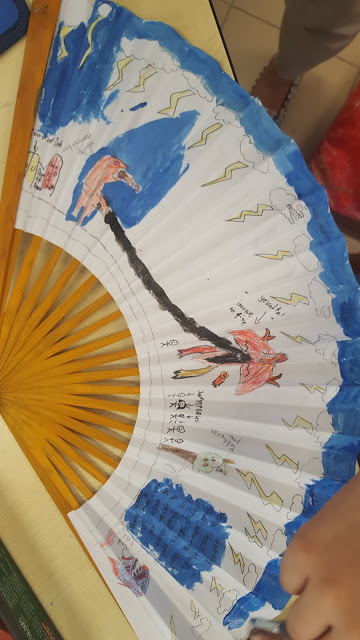Do you discuss something deliberately in class that's not exactly related to Art? I like to start my first lesson (especially to a new cohort of students) explaining to my students about the difference between equity and equality by introducing them my propaganda wall. In school, everyone recite the National Pledge during morning assembly daily. Since they are not going to receive the same treatment from me throughout the year, I think it's clearer to be explicit about my actions by adopting a single word from the National Pledge and began my lecture.
Tabs under construction!
Sunday, May 28, 2017
Thursday, May 25, 2017
Out of the Classroom!
I like seeing children learning beyond the four walls. To consider the environment as the third teacher, we've got another art room this year and we are doing away with furniture so that children can move more freely. Some small desks were bought with the intention of doing our class work in other parts of the school (like the school garden). The children can move around easily with the desk and make group work more convenient. Simple safety briefing were conducted first before usage and so far even the 7 years old are using them responsibly.
Labels:
spaces,
wall-less classroom
Sunday, May 7, 2017
Art Class: Understanding Understanding
In art class, we adopt the Havard Project Zero Thinking Routines for assessment. You can view the video below:
I enjoy reading the children's writing especially when their artwork has a personal connection to themselves. Time will usually reveal what is significant to the children. I told them that I snapped photos of their work so that everyone can learn from each other. It has more relevance when they know they are going to view/ read something from their friends rather than of the teacher's work sample. Art is also one of those subjects where children can use their 'heartware' (soul) instead of emphasizing on the 'hardware' (end product). It helps when I know more about the children because it helps in planning the kind the lessons that are important to know and engaging to them as well. For example, if the majority of the children are responsive to music then perhaps we could study the lyrics/ text in a song/ poem.
At the same time, I'm also using the assessment to gauge how the children respond and think if the lessons were effective. Different classes of the same level can react differently to the same lessons. There are days where I question my decision to teach. There are also good days where the aura of the class is particular good that it feels surreal.
Labels:
assessment,
primaryfive,
primaryfour,
reflection,
sketchbooks
Monday, May 1, 2017
Art Class: Salted Fish + Fan Painting
I tweaked this lesson from last year. You can view the previous lesson unit here.
Malaysia, Indonesia, Germany, Philippines, Russia, China, Vietnam etc. These are some of the profiles of children in my current cohort. There are a handful of them from mixed parentage. After studying about the Chinese artist, Cheong Soo Pieng's painting. The children painted on a paper fan by showing their cultures/ identities or their interests.
Malaysia, Indonesia, Germany, Philippines, Russia, China, Vietnam etc. These are some of the profiles of children in my current cohort. There are a handful of them from mixed parentage. After studying about the Chinese artist, Cheong Soo Pieng's painting. The children painted on a paper fan by showing their cultures/ identities or their interests.
Sunday, April 23, 2017
Art Class: The Great Pacific Garbage Patch (Part II)
The students' task for our current unit was to create awareness about their new knowledge using air-dry clay and painting the background. The children worked in 7 groups of 6. To cut down on washing time, I have the poster paint and cardboard palettes out for them to take whatever they need. So they will throw away the cardboard palettes and only wash the paintbrushes.
As the children start working, I will walk around and facilitate. By facilitating, sometimes I like asking children "what are you doing?" to ensure that they begin with an end in mind. Some children were more proactive than others so I would get them to organise the team in teams of individual contribution.
They were shown a photo compilation so that besides learning from each other in their own class, they will also be able to see what other classes were doing. I think they also feel comfortable seeing me going around taking photos as they know their identities will not be revealed but rather I emphasize on learning good practices from others. Be it painting techniques, concepts or written reflection.
As the children start working, I will walk around and facilitate. By facilitating, sometimes I like asking children "what are you doing?" to ensure that they begin with an end in mind. Some children were more proactive than others so I would get them to organise the team in teams of individual contribution.
They were shown a photo compilation so that besides learning from each other in their own class, they will also be able to see what other classes were doing. I think they also feel comfortable seeing me going around taking photos as they know their identities will not be revealed but rather I emphasize on learning good practices from others. Be it painting techniques, concepts or written reflection.
Labels:
plastics,
primaryfive,
recycled materials
Subscribe to:
Comments (Atom)





























































